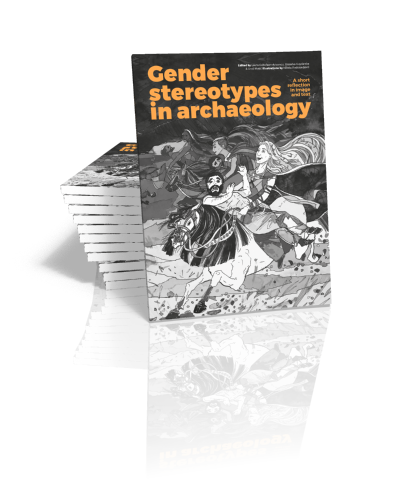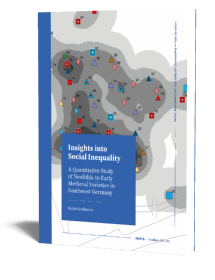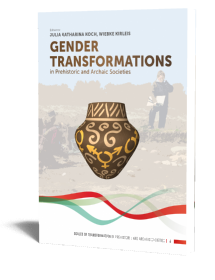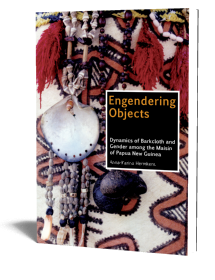Gender stereotypes in archaeology
A short reflection in image and text
Edited by Laura Coltofean-Arizancu, Bisserka Gaydarska & Uroš Matić | 2021

Gender stereotypes in archaeology
A short reflection in image and text
Edited by Laura Coltofean-Arizancu, Bisserka Gaydarska & Uroš Matić | 2021
Paperback ISBN: 9789464260250 | Imprint: Sidestone Press | Format: 200x270mm | 64 pp. | Series: HotAcademia | Language: English | 35 illus. (bw) | Keywords: gender; stereotypes; archaeology; inclusiveness; diversity | download cover
Read online or downloaded 13844 times
-
Digital & Online access
This is a full Open Access publication, click below to buy in print, browse, or download for free.
-
Buy via Sidestone (EU & UK)
-
Buy via our Distributors (WORLD)
This title is not available via our UK or USA distributors. You can place an order above in the EU section. We can ship worldwide, shipping costs will be added during ordering based on destination.
This title might be available via your local Amazon site, if so, you might be able to order there with zero or fewer shipping costs, if not, feel free to order in our EU section. Search for this book at Amazon .COM, .CO.UK, .FR, .DE or .CO.JP
-
Bookinfo
Paperback ISBN: 9789464260250 | Imprint: Sidestone Press | Format: 200x270mm | 64 pp. | Series: HotAcademia | Language: English | 35 illus. (bw) | Keywords: gender; stereotypes; archaeology; inclusiveness; diversity | download cover
Read online or downloaded 13844 times

We will plant a tree for each order containing a paperback or hardback book via OneTreePlanted.org.
Were men the only hunters and producers of tools, art and innovation in prehistory? Were women the only gatherers, home-bound breeders and caregivers? Are all prehistoric female depictions mother goddesses? And do women and men have equal career chances in archaeology? To put it short, no. However, these are some of the gender stereotypes that we still encounter on a daily basis in archaeology from the way archaeologists interpret the past and present it to the general public to how they practice it as a profession.
This booklet is a short but informative and critical response by archaeologists to various gender stereotypes that exist in the archaeological explanation of the past, as well as in the contemporary disciplinary practice. Gender and feminist archaeologists have fought for decades against gender stereotypes through academic writing, museum exhibitions and popular literature, among others. Despite their efforts, many of these stereotypes continue to live and even flourish, both in academic and non-academic settings, especially in countries where gender archaeology does not exist or where gender in archaeology is barely discussed. Given this context and the rise of far right or ultraconservative ideologies and beliefs across the globe, this booklet is a timely and thought-provoking contribution that openly addresses often uncomfortable topics concerning gender in archaeology, in an attempt to raise awareness both among the professionals and others interested in the discipline.
The booklet includes 24 commonly encountered gender stereotypes in archaeology, explained and deconstructed in 250 words by archaeologists with expertise on gender in the past and in contemporary archaeology, most of them being members of the Archaeology and Gender in Europe (AGE) Community of the European Association of Archaeologists. In addition, the stereotypes are beautifully illustrated by Serbian award-winning artist Nikola Radosavljević.
Challenging the status quo: deconstructing gender stereotypes in archaeology
Bisserka Gaydarska, Laura Coltofean-Arizancu and Uroš Matić
Stereotype 1 | Man, the hunter and field archaeologist vs. woman, the gatherer and laboratory analyst
Bettina Arnold
Stereotype 2 | Only women cooked in past societies
Marga Sánchez Romero
Stereotype 3 | Active men – passive women
Bettina Arnold
Stereotype 4 | Only women took care of the old and sick in past societies
Marga Sánchez Romero
Stereotype 5 | Only women cared about children in past societies
Katharina Rebay-Salisbury
Stereotype 6 | All women were young, slim and beautiful in the past, while all men were young, tall and athletic
Brigitte Röder
Stereotype 7 | Only men were violent in past societies
Uroš Matić
Stereotype 8 | Only high-ranking men were literate in the past
Agnès Garcia-Ventura
Stereotype 9 | Prehistoric societies were either matriarchal or patriarchal
Julia K. Koch
Stereotype 10 | Prehistoric female images are Mother Goddesses
Bisserka Gaydarska
Stereotype 11 | Families always consisted of a father, a mother and children
Julia K. Koch
Stereotype 12 | Two adult women buried together are the lady and her chambermaid
Julia K. Koch
Stereotype 13 | Sex and gender are the same
Katharina Rebay-Salisbury
Stereotype 14 | Binary sex and gender systems are natural
Sandra Montón-Subías
Stereotype 15 | There are only two genders
Pamela L. Geller
Stereotype 16 | Gender is universal
Alice B. Kehoe
Stereotype 17 | Gender as studied by gender archaeologists is an ideology
Uroš Matić
Stereotype 18 | Gender archaeology is practiced only by women and gay men
Rachel Pope
Stereotype 19 | Gender archaeology is only about women
Doris Gutsmiedl-Schümann
Stereotype 20 | There is no longer a need for dedicated gender archaeology
Nils Müller-Scheeßel
Stereotype 21 | Same-sex practices are a “modern” invention or a disorder
Uroš Matić
Stereotype 22 | Queer archaeology is just LGBTQIA+ researchers imagining past LGBTQIA+ people
Bo Jensen
Stereotype 23 | Women have equal career chances in archaeology as men
Maria Mina
Stereotype 24 | Archaeology is free of harassment, assault, bullying and intimidation
Laura Coltofean-Arizancu and Bisserka Gaydarska
Selected bibliography
List of authors
Laura Coltofean-Arizancu
Laura Coltofean-Arizancu is a DAAD Postdoctoral Research Fellow at the Römisch-Germanische Kommission (RGK; Frankfurt am Main) of the German Archaeological Institute. Previously, she was a postdoctoral researcher (2018-2020) in the Artsoundscapes ERC Advanced Grant Project at the University of Barcelona, Spain, and a museum curator (2012-2018) at the Brukenthal National Museum in Sibiu, Romania. Since 2018, she is co-chair of the Archaeology and Gender in Europe (AGE) Community of the European Association of Archaeologists. Her major publications include Interdisciplinarity and archaeology: Scientific interactions in nineteenth- and twentieth-century archaeology (edited with Margarita Díaz-Andreu; Oxford: Oxbow Books, 2021) and Handbook of the History of Archaeology (edited with Margarita Díaz-Andreu; Oxford: Oxford University Press, forthcoming).
Bisserka Gaydarska
Bisserka Gaydarska is an Honorary Fellow in Archaeology in the Department of Archaeology in Durham University, United Kingdom. Her major publications are Parts and wholes: fragmentation in prehistoric context (with John Chapman; Oxford: Oxbow Books, 2007) and Early urbanism in Europe: the case of the Trypillia mega-sites (author and main editor; Warsaw and Berlin: De Gruyter, 2020). Since 2019, she is co-chair of the Archaeology and Gender in Europe (AGE) Community of the European Association of Archaeologists.

Uroš Matić
Uroš Matić has obtained his PhD from the University of Münster (Germany) in 2017 and has since lectured at the Universities of Münster, Vienna, Graz and Innsbruck. He directed several stand-alone postdoctoral projects from 2018 to 2025 and participated on archaeological excavations and in museum studies in Egypt, Sudan and Lebanon. He received two prizes for his doctoral dissertation Body and Frames of War in New Kingdom Egypt: Violent Treatment of Enemies and Prisoners (Harrassowitz, 2019): the Philippika Prize of Harrassowitz in 2018 and Best Publication Award of the Austrian Academy of Sciences in 2020.
Abstract:
Were men the only hunters and producers of tools, art and innovation in prehistory? Were women the only gatherers, home-bound breeders and caregivers? Are all prehistoric female depictions mother goddesses? And do women and men have equal career chances in archaeology? To put it short, no. However, these are some of the gender stereotypes that we still encounter on a daily basis in archaeology from the way archaeologists interpret the past and present it to the general public to how they practice it as a profession.
This booklet is a short but informative and critical response by archaeologists to various gender stereotypes that exist in the archaeological explanation of the past, as well as in the contemporary disciplinary practice. Gender and feminist archaeologists have fought for decades against gender stereotypes through academic writing, museum exhibitions and popular literature, among others. Despite their efforts, many of these stereotypes continue to live and even flourish, both in academic and non-academic settings, especially in countries where gender archaeology does not exist or where gender in archaeology is barely discussed. Given this context and the rise of far right or ultraconservative ideologies and beliefs across the globe, this booklet is a timely and thought-provoking contribution that openly addresses often uncomfortable topics concerning gender in archaeology, in an attempt to raise awareness both among the professionals and others interested in the discipline.
The booklet includes 24 commonly encountered gender stereotypes in archaeology, explained and deconstructed in 250 words by archaeologists with expertise on gender in the past and in contemporary archaeology, most of them being members of the Archaeology and Gender in Europe (AGE) Community of the European Association of Archaeologists. In addition, the stereotypes are beautifully illustrated by Serbian award-winning artist Nikola Radosavljević.
Contents
Challenging the status quo: deconstructing gender stereotypes in archaeology
Bisserka Gaydarska, Laura Coltofean-Arizancu and Uroš Matić
Stereotype 1 | Man, the hunter and field archaeologist vs. woman, the gatherer and laboratory analyst
Bettina Arnold
Stereotype 2 | Only women cooked in past societies
Marga Sánchez Romero
Stereotype 3 | Active men – passive women
Bettina Arnold
Stereotype 4 | Only women took care of the old and sick in past societies
Marga Sánchez Romero
Stereotype 5 | Only women cared about children in past societies
Katharina Rebay-Salisbury
Stereotype 6 | All women were young, slim and beautiful in the past, while all men were young, tall and athletic
Brigitte Röder
Stereotype 7 | Only men were violent in past societies
Uroš Matić
Stereotype 8 | Only high-ranking men were literate in the past
Agnès Garcia-Ventura
Stereotype 9 | Prehistoric societies were either matriarchal or patriarchal
Julia K. Koch
Stereotype 10 | Prehistoric female images are Mother Goddesses
Bisserka Gaydarska
Stereotype 11 | Families always consisted of a father, a mother and children
Julia K. Koch
Stereotype 12 | Two adult women buried together are the lady and her chambermaid
Julia K. Koch
Stereotype 13 | Sex and gender are the same
Katharina Rebay-Salisbury
Stereotype 14 | Binary sex and gender systems are natural
Sandra Montón-Subías
Stereotype 15 | There are only two genders
Pamela L. Geller
Stereotype 16 | Gender is universal
Alice B. Kehoe
Stereotype 17 | Gender as studied by gender archaeologists is an ideology
Uroš Matić
Stereotype 18 | Gender archaeology is practiced only by women and gay men
Rachel Pope
Stereotype 19 | Gender archaeology is only about women
Doris Gutsmiedl-Schümann
Stereotype 20 | There is no longer a need for dedicated gender archaeology
Nils Müller-Scheeßel
Stereotype 21 | Same-sex practices are a “modern” invention or a disorder
Uroš Matić
Stereotype 22 | Queer archaeology is just LGBTQIA+ researchers imagining past LGBTQIA+ people
Bo Jensen
Stereotype 23 | Women have equal career chances in archaeology as men
Maria Mina
Stereotype 24 | Archaeology is free of harassment, assault, bullying and intimidation
Laura Coltofean-Arizancu and Bisserka Gaydarska
Selected bibliography
List of authors
Laura Coltofean-Arizancu
Laura Coltofean-Arizancu is a DAAD Postdoctoral Research Fellow at the Römisch-Germanische Kommission (RGK; Frankfurt am Main) of the German Archaeological Institute. Previously, she was a postdoctoral researcher (2018-2020) in the Artsoundscapes ERC Advanced Grant Project at the University of Barcelona, Spain, and a museum curator (2012-2018) at the Brukenthal National Museum in Sibiu, Romania. Since 2018, she is co-chair of the Archaeology and Gender in Europe (AGE) Community of the European Association of Archaeologists. Her major publications include Interdisciplinarity and archaeology: Scientific interactions in nineteenth- and twentieth-century archaeology (edited with Margarita Díaz-Andreu; Oxford: Oxbow Books, 2021) and Handbook of the History of Archaeology (edited with Margarita Díaz-Andreu; Oxford: Oxford University Press, forthcoming).
Bisserka Gaydarska
Bisserka Gaydarska is an Honorary Fellow in Archaeology in the Department of Archaeology in Durham University, United Kingdom. Her major publications are Parts and wholes: fragmentation in prehistoric context (with John Chapman; Oxford: Oxbow Books, 2007) and Early urbanism in Europe: the case of the Trypillia mega-sites (author and main editor; Warsaw and Berlin: De Gruyter, 2020). Since 2019, she is co-chair of the Archaeology and Gender in Europe (AGE) Community of the European Association of Archaeologists.

Uroš Matić
Uroš Matić has obtained his PhD from the University of Münster (Germany) in 2017 and has since lectured at the Universities of Münster, Vienna, Graz and Innsbruck. He directed several stand-alone postdoctoral projects from 2018 to 2025 and participated on archaeological excavations and in museum studies in Egypt, Sudan and Lebanon. He received two prizes for his doctoral dissertation Body and Frames of War in New Kingdom Egypt: Violent Treatment of Enemies and Prisoners (Harrassowitz, 2019): the Philippika Prize of Harrassowitz in 2018 and Best Publication Award of the Austrian Academy of Sciences in 2020.
-
Digital & Online access
This is a full Open Access publication, click below to buy in print, browse, or download for free.
-
Buy via Sidestone (EU & UK)
-
Buy via our Distributors (WORLD)
This title is not available via our UK or USA distributors. You can place an order above in the EU section. We can ship worldwide, shipping costs will be added during ordering based on destination.
This title might be available via your local Amazon site, if so, you might be able to order there with zero or fewer shipping costs, if not, feel free to order in our EU section. Search for this book at Amazon .COM, .CO.UK, .FR, .DE or .CO.JP
- Browse all books by subject
-
Search all books

We will plant a tree for each order containing a paperback or hardback book via OneTreePlanted.org.
You might also like:
© 2025 Sidestone Press KvK nr. 28114891 Privacy policy Sidestone Newsletter Terms and Conditions (Dutch)








